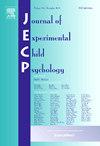幼儿ASD的发展性模仿与理性模仿是否相关?
IF 2
2区 心理学
Q3 PSYCHOLOGY, DEVELOPMENTAL
引用次数: 0
摘要
本研究采用相关设计来检验23-48个月大的自闭症谱系障碍(ASD)儿童(n = 40)和12-24个月大的正常发育(TD)儿童(n = 42)的指示模仿、自发模仿和理性模仿之间的关系。该研究利用开创性实验、头触范式和隐藏盒子来衡量理性模仿。此外,该研究首次在文献中使用IMETCHASD作为替代工具来测量互动游戏环境中的指示模仿和自发模仿。结果表明,自发性模仿与理性模仿存在相关性。在控制认知水平后观察到这些关联。然而,研究并没有发现两组的指导性模仿和理性模仿之间有显著的相关性。从理性模仿发生的理论解释和进一步的研究需要两方面讨论了这一关系的含义。本文章由计算机程序翻译,如有差异,请以英文原文为准。
Is developmental imitation related to rational imitation in young children with ASD?
This study used a correlational design to examine associations between instructed imitation, spontaneous imitation, and rational imitation in children with autism spectrum disorder (ASD) between 23–48 months of age (n = 40) and typically developing (TD) children between 12–24 months of age (n = 42). The study utilized seminal experiments, the head-touch paradigm, and the hidden box to measure rational imitation. Also, the study first utilized IMETCHASD as an alternative tool in the literature to measure instructed imitation and spontaneous imitation in an interactive play context. Results showed that spontaneous imitation was associated with rational imitation in ASD. These associations were observed after controlling for cognitive level. However, the study did not find significant correlations between instructed imitation and rational imitation in both groups. Implications for the relationship are discussed in terms of theoretical accounts for the occurrence of rational imitation and further research needs.
求助全文
通过发布文献求助,成功后即可免费获取论文全文。
去求助
来源期刊

Journal of Experimental Child Psychology
Multiple-
CiteScore
4.50
自引率
7.70%
发文量
190
期刊介绍:
The Journal of Experimental Child Psychology is an excellent source of information concerning all aspects of the development of children. It includes empirical psychological research on cognitive, social/emotional, and physical development. In addition, the journal periodically publishes Special Topic issues.
 求助内容:
求助内容: 应助结果提醒方式:
应助结果提醒方式:


